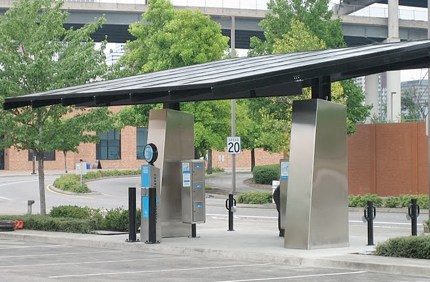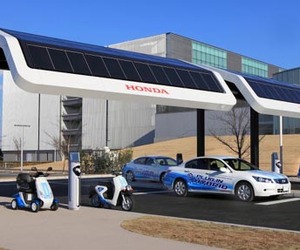
| Monday, August 22, 2011 | Archives | Advertise | Online Buyer's Guide | FLEETSolutions |
Opinion: The Future Of The Plug-In Car In A Power-Drained Present
 Donald W. Dunphy thinks over the demand for electricity right now, and what that might mean if the U.S. falls in love with the Electric Vehicle. Donald W. Dunphy thinks over the demand for electricity right now, and what that might mean if the U.S. falls in love with the Electric Vehicle.2011's severe summertime heat has been a major issue in the U.S., extending across the country since mid-July, resulting in triple-digit heat indexes and related deaths. For those who believe these extremes are stemming from climate change, the situation is only going to get worse, meaning longer, hotter summers and colder winters. Electric companies are dealing with taxed power grids and rolling blackouts right now, compensating for the increased usage. On July 23, New York City Mayor Michael Bloomberg implored citizens. "We need people to turn their air conditioners to no cooler than 79, if you can do that," just to keep from overloading and knocking out the system. Now consider what kind of additional drain could be on the horizon with the widespread acceptance of electric vehicles. Think about the prospect of a large driver base needing to tap into that supply every day, sometimes twice a day, on top of what's already being consumed. According to the Energy Information Administration (EIA), mid-July's electricity prices soared, jumping 3.5 times above normal, thanks to the increased drain of air conditioning and other cooling systems. If that resulted in such a drastic taxing of the infrastructure, a nation of plug-in vehicle users charging up their cars represents an altogether unprecedented step up in future usage. Grid studies by-and-large have been forgiving when it comes to how the plug-in revolution would affect the current setup, but plug-in builder and EV advocate Better Place, based in Palo Alto, CA, was blunt regarding the impact of plug-ins on electricity pricing. According to Better Place, without centralized smart grid technologies and "smart-charging" regimen, simply "plugging in" one million electric cars could add $750 million in annual wholesale energy costs. Even with such technologies in place, electricity prices would still be adversely raised. Although plug-in fueling costs would be cheaper than combustible engine costs, higher electricity prices will ultimately occur. The average EV sticker price is considerably higher than current vehicles and issues of range haven't yet been satisfactorily addressed (introducing the term "range anxiety," the fear of running out of juice before reaching the destination, into the lexicon). Some entrepreneurs are banking on solar-powered chargers as being a possible fix for the problem, but they present as many questions as they seek to address. First, there is a question of size. Most of what is currently being offered is a large-scale canopy suitable for corporate, not personal, use. For fleets it might be ideal, but for individuals, major construction costs as well as property considerations (not to mention the base cost of buying one of these things) likely would prove prohibitive. Then there is the consistency issue, of storing collected energy for later use, and what one does when nature doesn't allow energy to be collected at all (rain, cloudy conditions, winter hours, etc.). Furthermore, as Don Henley once sang, "how bad do you want it?" Chargers offer different levels of charge-per-hour. Mitsubishi's latest chargers, given the optimal conditions, will bring a car battery up to eighty percent capacity in twenty-five minutes, which isn't bad. If you would rather have a full charge to allay your range anxiety, that will cost you twenty-two hours.  This brave new world of power demand needs to be paid for. Gasoline taxes only make sense if people are still buying gas, offering little from a potential EV-driving majority. Vehicle-miles-traveled (VMT) taxes could supply funds to infrastructure projects not from fuel purchases but from the total of miles one accrues during a period. While being a viable solution, it would also prove highly unpopular, and in a current no-tax culture in Washington D.C., it is hard to speculate its passage at all, no matter how necessary. This brave new world of power demand needs to be paid for. Gasoline taxes only make sense if people are still buying gas, offering little from a potential EV-driving majority. Vehicle-miles-traveled (VMT) taxes could supply funds to infrastructure projects not from fuel purchases but from the total of miles one accrues during a period. While being a viable solution, it would also prove highly unpopular, and in a current no-tax culture in Washington D.C., it is hard to speculate its passage at all, no matter how necessary.Two things are certain though. An EV future is going to be more expensive, and it will likely only get hotter from here on. For more about Better Place's infrastructure and power grid usage study, read the White Paper PDF at: www.betterplace.com What's your opinion? Join the discussion of this and other fleet and auto-related topics. Visit LinkedIn and find the NAFA Fleet Management Association page to weigh in. The opinion expressed is solely of the writer's and does not necessarily represent the viewpoint of NAFA Fleet Management Association. |
 |
NAFA Fleet Management Association 125 Village Blvd., Suite 200 Princeton, NJ 08540 Telephone: 609.720.0882 Fax: 609.452.8004 |






